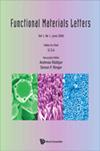Effect of Silica Morphology on Rheological Properties and Stability of Magnetorheological Fluid
IF 1.1
4区 材料科学
Q4 MATERIALS SCIENCE, MULTIDISCIPLINARY
引用次数: 0
Abstract
SiO 2 is commonly used as an abrasive in optical devices and magnetorheological (MR) fluid. In this study, MR fluid with composite and free-state SiO 2 were prepared. Composite magnetic particles of CIP@SiO 2 were synthesized using the sol-gel method with tetraethyl orthosilicate (TEOS) as the silicon source. Performance test results showed that CIP@SiO 2 MR fluid exhibited superior mechanical properties compared with CIP MR fluid under zero magnetic field conditions. However, under the influence of a magnetic field, the SiO 2 shell weakened the response of CIP@SiO 2 MR fluid to the magnetic field, whereas CIP MR fluid demonstrated better rheological properties. The addition of free-state SiO 2 to CIP MR fluid significantly improved its rheological performance. At a volume fraction of 6% SiO 2 , the shear stress and viscosity reached their maximum values, and further increasing the volume fraction to 8% resulted in a noticeable decrease in rheological behavior. Stability improved with an increase in magnetizable particle content. The stability of CIP MR fluid at the same concentration was superior to that of CIP@SiO 2 MR fluid, while free-state SiO 2 had a notable enhancing effect on stability. Therefore, when SiO 2 exists as a free-state abrasive, the rheological properties and stability of the MR fluid considerable improve.二氧化硅形态对磁流变液流变性能及稳定性的影响
二氧化硅通常用作光学器件和磁流变(MR)流体的磨料。本研究制备了具有复合和自由态二氧化硅的磁流变液。以正硅酸四乙酯(TEOS)为硅源,采用溶胶-凝胶法制备了CIP@SiO 2的复合磁性颗粒。性能测试结果表明,CIP@SiO 2磁流变液在零磁场条件下比CIP磁流变液表现出更优异的力学性能。然而,在磁场的影响下,sio2壳层削弱了CIP@SiO 2磁流变液对磁场的响应,而CIP磁流变液表现出更好的流变性能。在CIP MR流体中加入自由态sio2,显著改善了CIP MR流体的流变性能。当sio2体积分数为6%时,剪切应力和粘度达到最大值,进一步将体积分数增加到8%时,流变行为明显下降。稳定性随着可磁化颗粒含量的增加而提高。相同浓度下CIP磁流变液的稳定性优于CIP@SiO 2磁流变液,而自由态sio2对其稳定性有显著的增强作用。因此,当sio2以自由态磨料存在时,磁流变液的流变性能和稳定性显著提高。
本文章由计算机程序翻译,如有差异,请以英文原文为准。
求助全文
约1分钟内获得全文
求助全文
来源期刊

Functional Materials Letters
工程技术-材料科学:综合
CiteScore
2.40
自引率
7.70%
发文量
57
审稿时长
1.9 months
期刊介绍:
Functional Materials Letters is an international peer-reviewed scientific journal for original contributions to research on the synthesis, behavior and characterization of functional materials. The journal seeks to provide a rapid forum for the communication of novel research of high quality and with an interdisciplinary flavor. The journal is an ideal forum for communication amongst materials scientists and engineers, chemists and chemical engineers, and physicists in the dynamic fields associated with functional materials.
Functional materials are designed to make use of their natural or engineered functionalities to respond to changes in electrical and magnetic fields, physical and chemical environment, etc. These design considerations are fundamentally different to those relevant for structural materials and are the focus of this journal. Functional materials play an increasingly important role in the development of the field of materials science and engineering.
The scope of the journal covers theoretical and experimental studies of functional materials, characterization and new applications-related research on functional materials in macro-, micro- and nano-scale science and engineering. Among the topics covered are ferroelectric, multiferroic, ferromagnetic, magneto-optical, optoelectric, thermoelectric, energy conversion and energy storage, sustainable energy and shape memory materials.
 求助内容:
求助内容: 应助结果提醒方式:
应助结果提醒方式:


